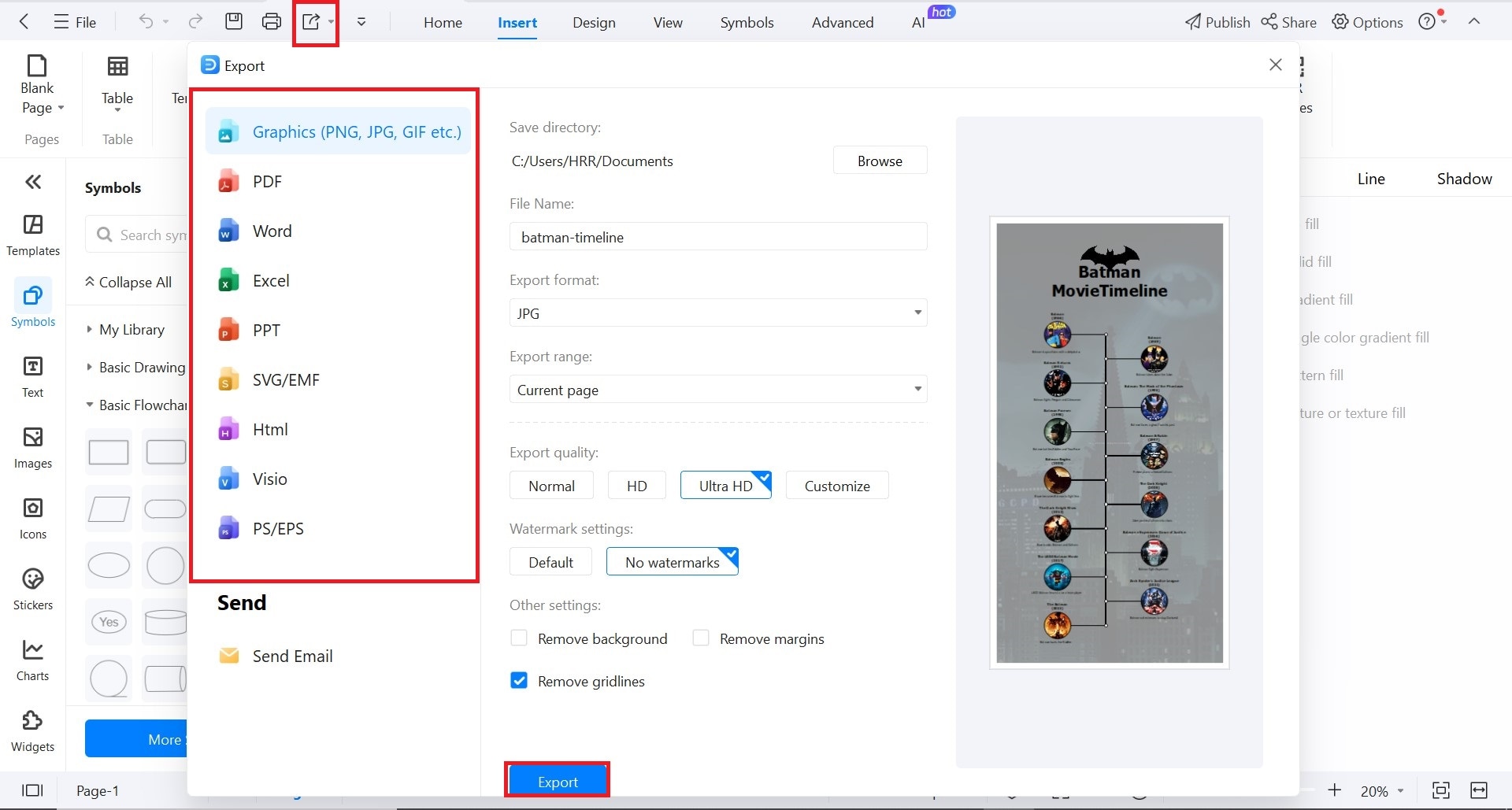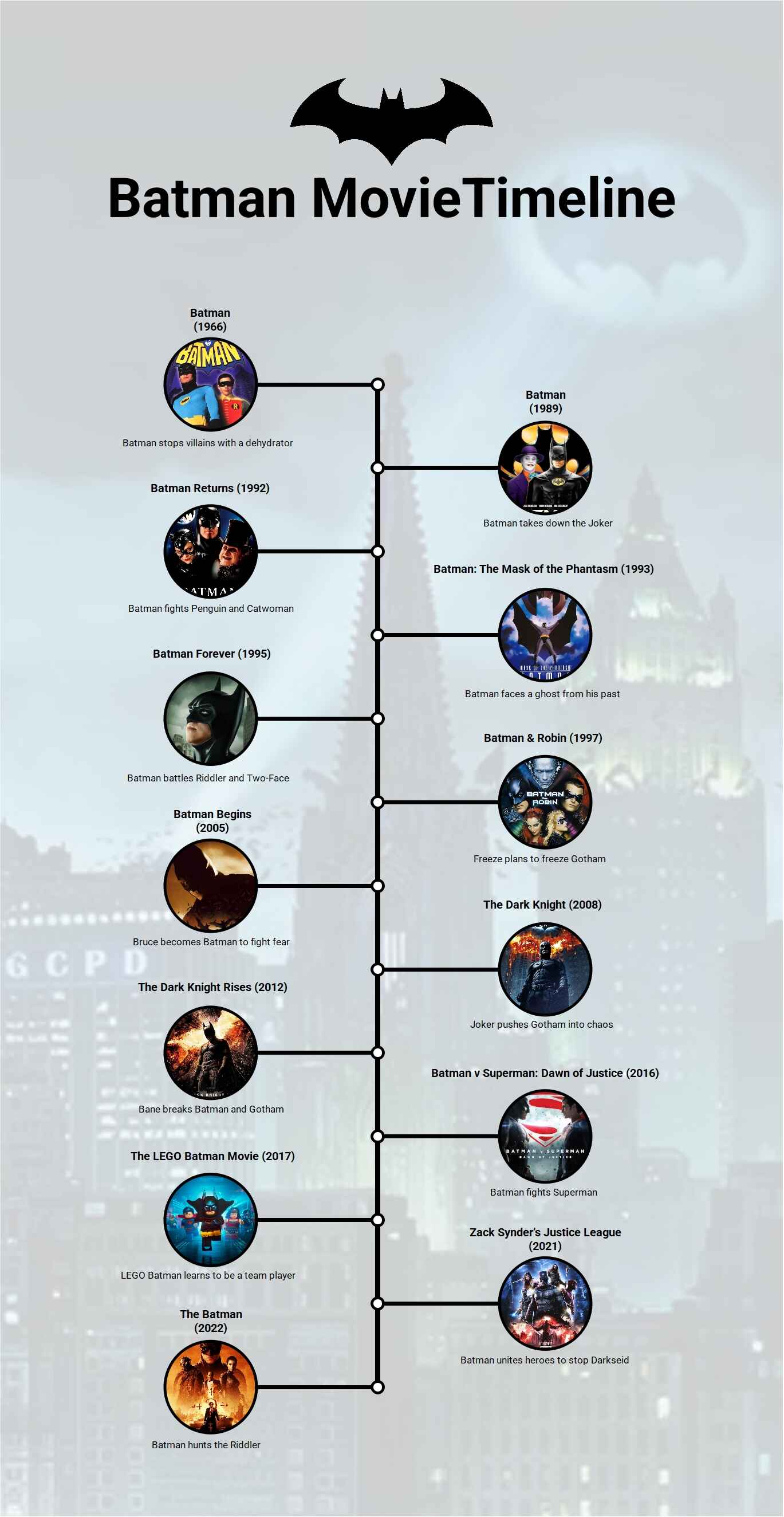Batman has been captivating audiences for decades. From comics to movies, each version of the Dark Knight offers something new.
Watching Batman in chronological order is a great way to understand his evolution and growth as a character.
This timeline covers everything—from the earliest comic appearances to the latest cinematic reboots.
Each phase of Batman’s journey reflects changes in society, technology, and storytelling.
Whether you're a longtime fan or just starting, this guide will help you experience Batman’s story in the right order.
Get ready to follow Gotham’s protector through the highs and lows of his legendary career.
In this article
The Complete Batman Movie Timeline: 13 Films from 1966 to 2022
Batman has always been one of the most versatile superheroes, with each new iteration reflecting the shifting cultural landscape and the changing expectations of audiences. From the campy, colorful days of the 1960s to the darker, more introspective takes in recent years, the Batman movie timeline offers a fascinating journey through over half a century of storytelling. Here’s a look at all 13 major Batman films, from 1966 to 2022.
1. Batman: The Movie (1966)
The journey begins with Batman: The Movie, based on the beloved TV series starring Adam West. This film was a lively, over-the-top spectacle filled with comic book-style action. The Batman of this era was anything but grim—he was lighthearted, witty, and unburdened by the darkness that would define future versions. With its campy tone and bright colors, it was the perfect reflection of the 60s, aimed more at fun than philosophy.
2. Batman (1989)
Tim Burton’s Batman in 1989 marked a sharp departure from the light-hearted tone of the 1960s. Starring Michael Keaton as the Dark Knight, this film introduced a darker, more serious version of Batman. Burton's Gotham was gothic and grim, and Keaton’s Batman was mysterious and emotionally conflicted, reflecting a more mature take on the character. This was a game-changer for superhero films, establishing Batman as a symbol of darkness and internal struggle.
3. Batman Returns (1992)
Burton returned with Batman Returns, continuing his dark vision for Gotham. This time, Batman faces off against the grotesque Penguin and the cunning Catwoman. The film is an even deeper exploration of the character’s isolation and the bizarre nature of Gotham’s villains. While it was praised for its visual style, it also deepened Batman’s psychological complexity.
4. Batman Forever (1995)
Joel Schumacher took over the franchise with Batman Forever. This film introduced Val Kilmer as Batman and embraced a brighter, more colorful aesthetic. While the movie leaned into neon lights and more flamboyant villains like Jim Carrey’s Riddler, it still touched on Bruce Wayne’s internal conflicts, even if the tone was noticeably lighter than Burton’s films.
5. Batman & Robin (1997)
Schumacher’s follow-up, Batman & Robin, was a critical misfire. Starring George Clooney, this film went full camp with over-the-top characters like Arnold Schwarzenegger’s Mr. Freeze and Uma Thurman’s Poison Ivy. It was a chaotic mix of ridiculousness, neon, and toyetic visuals that failed to resonate with fans. It marked the end of the ‘90s Batman era and a much-needed break from the franchise.
6. Batman Begins (2005)
After the downfall of Batman & Robin, Christopher Nolan rebooted the series with Batman Begins, starring Christian Bale. This film revitalized the character, grounding him in a realistic world where Bruce Wayne’s transformation into Batman was portrayed as a psychological journey. Nolan’s Gotham was gritty, dark, and more realistic, bringing depth and emotional complexity to the character like never before.
7. The Dark Knight (2008)
The second film in Nolan's trilogy, The Dark Knight, is widely considered one of the greatest superhero films of all time. With Heath Ledger’s unforgettable performance as the Joker, the film explored deep philosophical questions about chaos, order, and morality. Batman was pushed to his limits, not just physically but emotionally and ethically, as he faced a villain who challenged his every belief.
8. The Dark Knight Rises (2012)
The trilogy concluded with The Dark Knight Rises, where Batman faces the terror of Bane, a villain determined to break both Gotham and Bruce Wayne. This film concluded the arc of Nolan’s Batman, focusing on redemption, sacrifice, and the consequences of being a hero in a broken world.
9. Batman v Superman: Dawn of Justice (2016)
In Batman v Superman, Ben Affleck's older, world-weary Batman confronts Henry Cavill’s Superman. This film, directed by Zack Snyder, is darker, exploring the ideological differences between the two heroes. The film laid the groundwork for the broader DC Extended Universe and introduced a more brutal Batman who was willing to take extreme measures to defeat his enemies.
10. Suicide Squad (2016)
Though Batman’s role in Suicide Squad is brief, his presence looms large. Played again by Ben Affleck, Batman’s interactions with the Suicide Squad set the stage for the growing DCEU and provided a more hardened, aggressive version of the character.
11. Justice League (2017)
In Justice League, Batman unites a team of superheroes to battle a world-threatening invasion. Affleck’s Batman is at the forefront of this team, dealing with the responsibility of leading the charge against the forces of evil. This film didn’t resonate as strongly as Nolan’s trilogy but further developed Batman’s role in the larger DC Universe.
12. Zack Snyder’s Justice League (2021)
In Zack Snyder’s Justice League, the darker, more expansive cut of the original 2017 film was released. This version gave Batman more screen time, expanding on his internal conflict and leadership in the face of an impending apocalypse.
13. The Batman (2022)
Finally, Robert Pattinson brought a new iteration of the Dark Knight to the screen in The Batman (2022). This film, directed by Matt Reeves, focuses on Batman as a detective, exploring his early days as Gotham’s protector. Pattinson’s portrayal of a younger, more vulnerable Bruce Wayne adds layers of uncertainty to the character, creating a noir-inspired version of Batman that is raw, introspective, and more grounded.
How To Make a Timeline Easily For Free?
Timelines make everything easy to follow. Whether it’s a messy set of business plans or just a movie plot you’re trying to lay out. Putting things in order with a timeline helps you see things in perspective.
But making one from scratch? That can feel like a lot, especially with research at hand. That’s where EdrawMax helps. The software’s intuitive drag-and-drop tools, clean template designs, and AI integration take the stress out of design. So you can focus on telling the story, not formatting it.
Here’s how you can create a timeline with EdrawMax. Follow the steps below to make a timeline in 6 easy steps.
Step 1Access EdrawMax
- Download EdrawMax
- Log in to sign up with your Wondershare account.
- Once logged in, you'll be directed to the home dashboard.

Step 2Start a New Timeline
- To get started, head to Basic Diagram > Timeline.
- Choose Blank Drawing to build a custom timeline.
- Or explore the Template Gallery for a quicker start.
- Templates include event-based (like the Batman timeline), horizontal or Gantt-style, etc.

Step 3Choose and Edit Timeline
- Once on the blank canvas, look to the quick-access panel on the top.
- Go to Insert > Timeline.
- Browse from horizontal and vertical timeline bar styles.
- Pick one that fits your project, and hit OK.
- Drag the side handles to resize or tweak it.
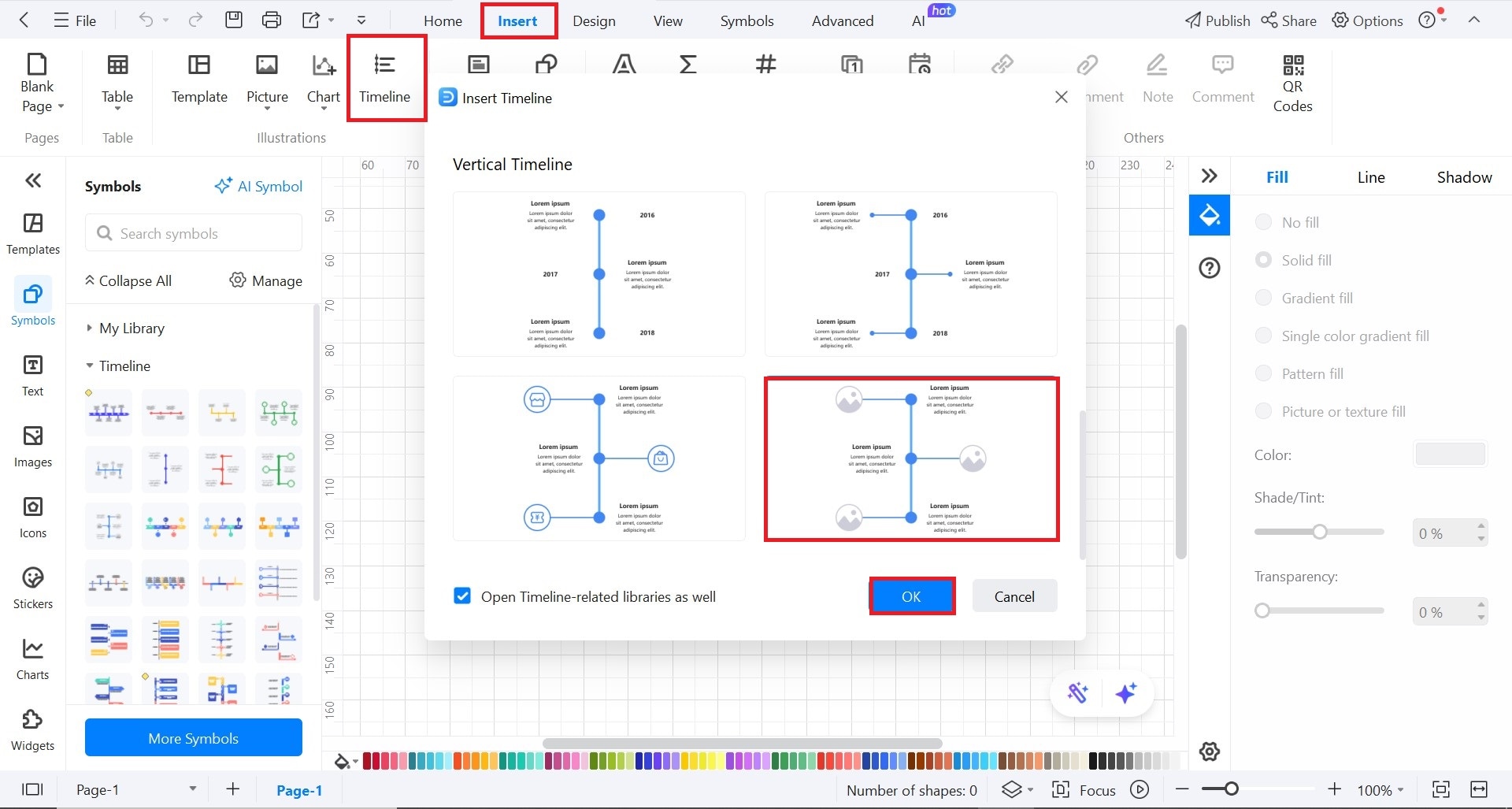
Step 4Fill in Your Timeline
- Double-click anywhere to enter text like dates, events, or milestones.
- Alternatively, head to the left side panel, click Text to add a text body.
- Add new points, delete extras, or drag them around to rearrange the order.
- Use the floating toolbar to tweak font style, size, or colors.
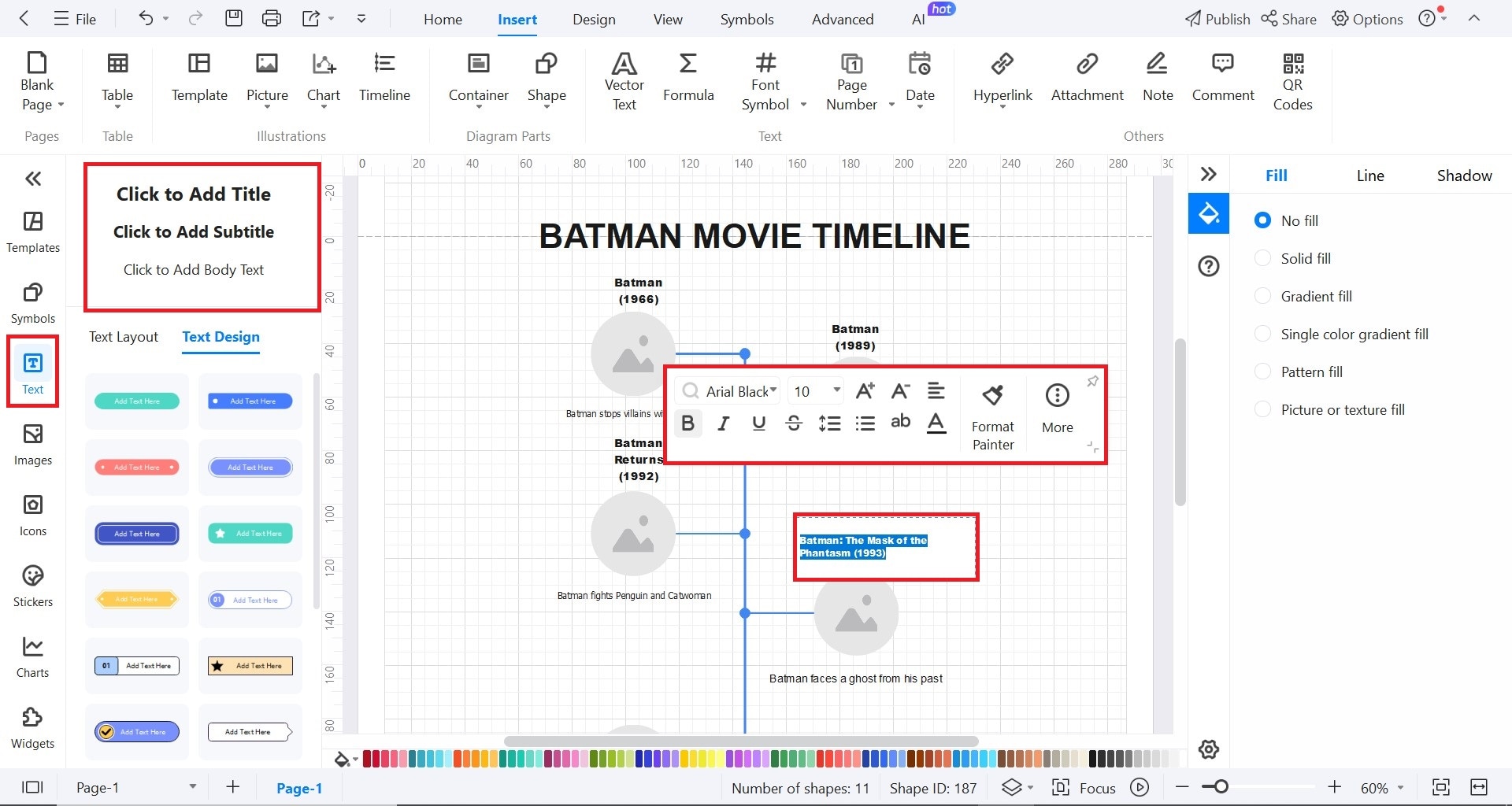
Step 5Enhance Timeline
- Customize node colors using the color palette at the bottom of the canvas.
- To add relevant images, go to Insert > Picture > Local pictures.
- Drop the image in the sample image area.
- It will resize automatically according to the area.
- Repeat the same procedure for the background image.
- From the floating bar, select Send to Back.
- Click Adjust > Transparency to ensure the front text’s readability.
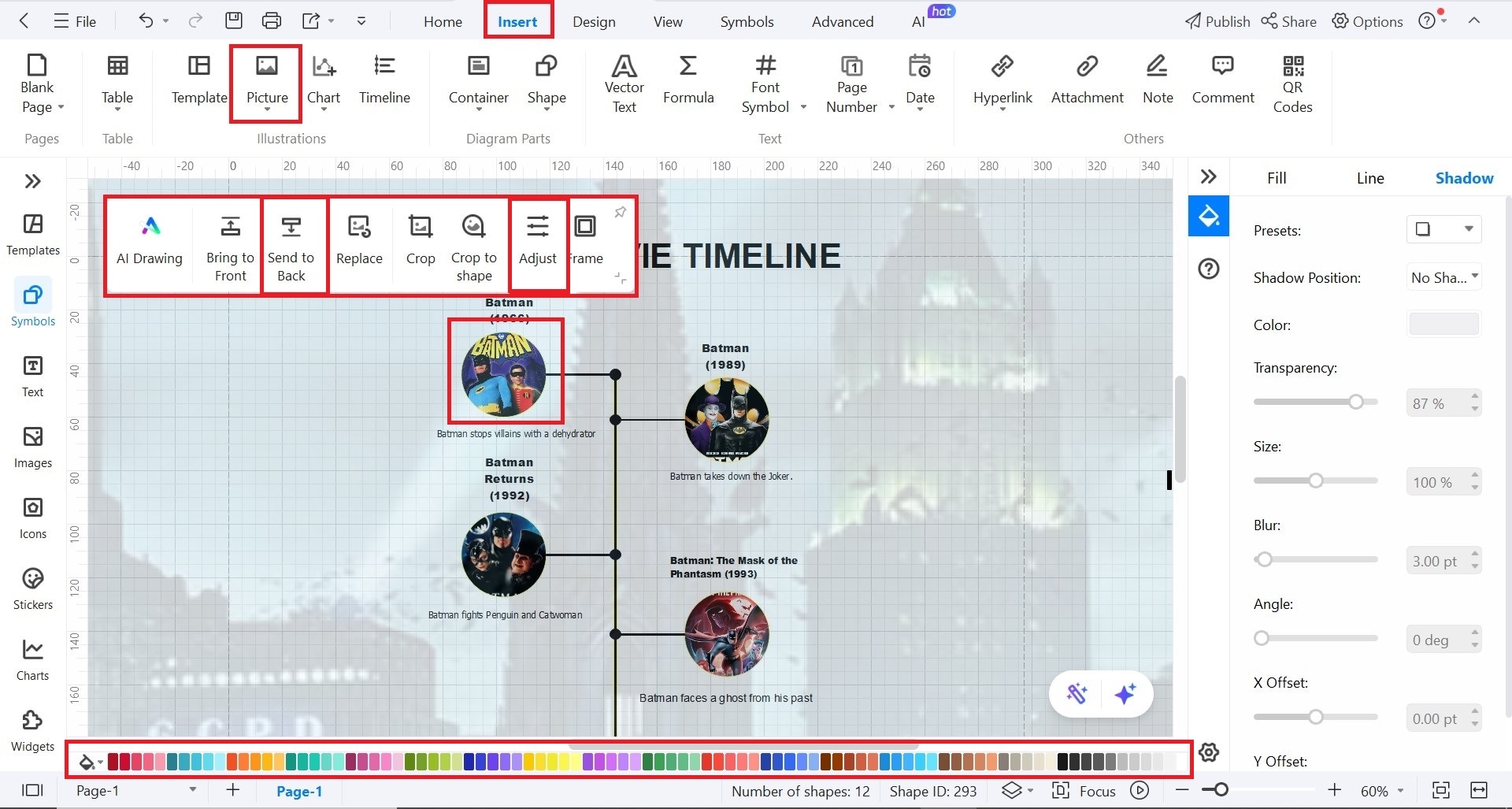
Step 6Save and Export Timeline
- Click the Export button in the top-left menu.
- Choose your desired file format:
- PNG/JPG for images
- PDF for documents
- PPTX to use in PowerPoint
- Excel (XLSX) to keep numerical data
- You can access your timeline through your EdrawMax cloud or your device directory.
